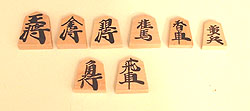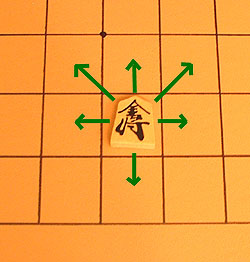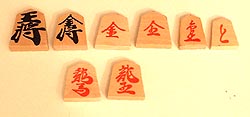| |
|
An Illustrated History of Chess_________________7____
It
has been said that Japan takes in ideas from all over the world,
and reinvents them in a style which is uniquely Japanese. As you
will see, the game of shogi illustrates this idea beautifully.
Looking at the shogi board, at right, what similarities to other
forms of chess are already apparent?
Like the Chinese game:
T he pieces are flat, caligraphed figures, nine across, with the
commanding general (king) in the center, and there are two special
pieces on their own row.
Like the Persian game:
The pieces are placed on the spaces (not lines), and there is
a pawn in each column.
Like the Thai game:
T he pawns start out on the third row...
And
yet, the neat wooden board, divided into rectangles, with wooden
tiles seems to have a very Japanese character.
|

the initial array of shogi |

You may be able to detect a few similarities between the Chinese
pieces (above) and the Japanese pieces (below).
 |
 In
fact, the Japanese pieces are written in Chinese characters (one
of Japan's three official alphabets!). The Japanese pieces,
however, are composed of two characters — the first is an
adjective. For instance, look at the fourth and fifth pieces in
the Chinese and Japanese line-up at the left. The Chinese pieces
are "horse" and "chariot." The corresponding
Japanese pieces are "laurel horse" and "fragrant
chariot."
In
fact, the Japanese pieces are written in Chinese characters (one
of Japan's three official alphabets!). The Japanese pieces,
however, are composed of two characters — the first is an
adjective. For instance, look at the fourth and fifth pieces in
the Chinese and Japanese line-up at the left. The Chinese pieces
are "horse" and "chariot." The corresponding
Japanese pieces are "laurel horse" and "fragrant
chariot."
Notice
the two pieces which stand alone on the second row. Strangely
enough, one has the move of a western bishop (called, "angle-goer")
and one has the move of the western rook (called "flying
chariot" — did you recognize the character for chariot?).
It is said that the historic line-up of shogi pieces did not have
anything in the second row, and that these pieces were simply
borrowed, several centuries ago, from European chess. |
Most
of the moves found in shogi are already already familiar to us,
and some are slight variations on familiar themes. The chariot
and horse, for instance, move like our rook and knight...but only
in the forward directions. The pawn moves and captures
with a forward movement, like the Chinese pawn.
Now,
let's talk about elephants. Well, there is no elephant
in the Japanese chess...but that piece two spaces to the king's
right and left, the silver general — has the characteristic
elephant move found in Southeast Asia — just like the nobleman
of Thai chess.
|

the move of the silver general |

the move of the gold general
|
What's
new in shogi is the move of the gold general, who stands
next to the king (or jaded general). The gold general
moves one space forward, backward of sideways or forward-diagonal.
This is an interesting complement to our silver general,
who moves in the four diagonal directions or to
the one forward direction. You can see that there is a preference
in shogi for the pieces to move forward — on the attack.
|
Now, here's where things start to get complicated. Notice that
the pieces are all flat tiles. This shape serves a special function:
Each player starts with twenty pieces, and all but three of these
pieces (the king and two gold generals) can flip over, to show
a promotional value.
Promotion
occurs when a piece enters the enemy's third row (as it does in
Thai chess). Upon entering the promotional zone, the piece may
flip over (as the pawn does in Thai chess) to show a new character.
The newly promoted piece has a new, more powerful move, becoming
at once a greater threat in the enemy's territory. |


All
of the shogi pieces, except the king and the gold general, flip
over to show a promoted value. |
But here's where things get really complicated. Did
you notice that the pieces on opposing sides are all of the
same color, only differentiated by the direction they are pointing?
There is a reason for that too.
When a piece is captured in shogi, it isn't dead yet! It waits
on the side of the board, to be placed back in the service of
its captor, on any vacant square of the board (some
restrictions apply). So, unlike all other forms of chess, shogi
never winds down into a simplified end game. No, in
shogi there are 40 pieces in play, from beginning to end, being
promoted, captured, dropped back into play, being promoted and
captured again...until, finally, someone declares checkmate!
If
you think an intense game loaded with extraordinary possibilities
of attack and necesities for tight defense is for you, check
out the detailed rules
of shogi!
That
just about completes our tour of the Far East. It is by no means
exhausted! There are varieties of chess still played in India
and Myanmar... and myriad variations and predecessors of the
games we've looked at throughout history.
But
let's finish our world view with a look at the chess we know
and love, western chess — just plain "chess,"
as we call it. How did it get here, and how long has it
been around?...
<<Previous
Page ... Next Page>>
|
__
|
|






